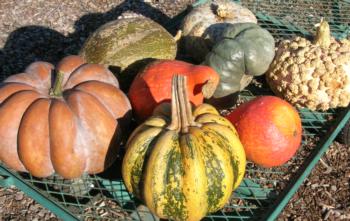Winter Squash (including pumpkins)
Summer squashes such as zucchini are harvested young and eaten immediately. Despite its name, winter squash is grown in the summer. The name comes from the fact that the mature fruits can be stored for winter eating. Pumpkins are also types of winter squash.
UC Links
How to grow: Winter Squash
Pest management: Squash cultural tips, pests, and diseases
The Basics
When to plant
- Transplant or direct seed: May–June
- For best results, wait until daytime temperatures are regularly over 75°F and soil temperature is over 65°F
- Start in pots for transplants: April–May; ready to transplant in 4 weeks
Harvest window: September–November, depending on variety
Care overview:
- Encourage bees for best pollination.
- Train vining squash plants on trellises or cages to conserve space in your garden, or let ramble over non-garden surfaces. Bush varieties are more compact.
- Treat squash bugs aggressively if found on plants.
Harvesting and storage:
- Mature winter squash have a hard outer shell and a well-corked stem.
- Immature fruit have a tender skin and a fleshy stem. They won't keep in storage but can be used like summer squash.
- Any injury to the rind can be a site for decay, including if the stem has broken off, so use damaged squash first.
- Winter squash are best stored at 55–59°F and can last 2 to 6 months depending on the variety. Cucurbita pepo types such as acorn, spaghetti, and delicata are best eaten in the fall. Cucurbita maxima types such as hubbard, buttercup, and kabocha squash are best eaten in December/January; their sweetness will actually increase during storage. Cucurbita moschata types such as butternut will store the longest.
Recommended Varieties for Santa Clara County*
| Blue Ballet | Smaller version of Blue Hubbard, averaging 4–6 lbs. Rind is blue-gray, bright orange flesh is sweet and smooth. Skin is more tender than other hubbards. C. maxima |
| Buttercup | Small, dense fruits average 3 lbs. Skin is dark green skin with pale green stripes. Orange flesh is sweet, rich and dry. C. maxima |
| Butternut | Small fruits average 3–6 lbs. Skin is a uniform tan. Golden flesh is nutty and sweet. Some resistance to squash bugs. C. moschata |
| Delicata | Little oblong fruits average 1 1/2 to 2 lbs. Skin is creamy white with dark green stripes. Golden flesh is sweet and smooth. C. pepo |
| Stella Blue | Small flattened round fruits are 2–6 lbs. Skin is slate blue. Deep orange flesh is sweet, dry, and flaky. C. maxima |
| Sweet Dumpling | Tiny round fruits average just 1 lb. Skin is creamy white with dark green rib stripes. Orange flesh is tender and sweet. C. pepo |
| Tahitian | Large fruits average 8–30 lbs and look like a giant butternut squash. Flesh is unusually sweet. Some resistance to squash bugs. C. moschata |
* Many other varieties may also do well here in Santa Clara County. This list is based on UC Master Gardener trials, taste tests, and feedback from local growers.







